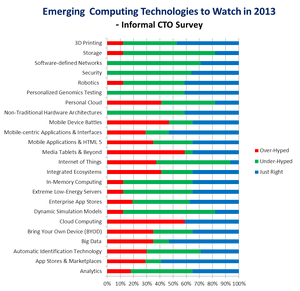Cliff, Cliff on the Hill: Which Emerging Computing Technologies (ECT) to Watch in 2013?
Our best wishes to you, your families and friends for a Happy, Healthy, and Prosperous New Year. Much of 2012 was a stimulating hike through the emerging computing technology (ECT) landscape; with the last month or so being an exciting steep ascent culminating at the ECT Cliff. Our year-end climb started with our participation at the exciting annual <a href=”http://sc12.supercomputing.org/” target=”_blank” rel=”noopener”>Supercomputing 2012</a> event (#SC12) in Salt Lake City in Utah. Then, we attended the annual #IBM Software Analyst Insights conference in Stamford, CT. And finally, we attended the monthly Connecticut Chief Technology Officers (CTO) club in mid-December before winding down for our annual holiday in 2012.
December 2012 Connecticut CTO Club Meeting Informal Survey – 2013 will be the Year for Analytics!
At our last CTO club meeting for 2012, we had a vigorous and stimulating discussion on what the group assembled there considered were the key emerging computing technologies to watch in 2013. We put up a list and then this group of about 18 individuals representing technical leaders across various companies – large and small – in southern Connecticut and New York – voted on whether they thought these technologies were Over-Hyped, Under-Hyped, or Just Right.

Greater the Impacts When Several ECT Trends Combine …..
We are always awed by the potential impact of any one ECT trend, but we become ecstatic when several ECT trends combine together to significantly improve our personal and professional lives….each ray of the rising sun is lovely, but when these rays coalesce and illuminate the vast gorgeous valley below the cliff, that view is breathtakingly stunning!
….. Under the Leadership of Enterprising Individuals
But we need enterprising doers, managers, and leaders to invent, develop, nurture, evangelize, adopt, and use these Emerging Computing Technologies. In 2012, we have been very fortunate to interact with several enterprising individuals. Clearly, the members of the Connecticut CTO club and the Faculty, Staff and Industry Members of the Wharton Emerging Technology Center are enterprising individuals with a passion for ECT. But I wanted to specifically call out others who we recently met or interacted with at #SC12 or the IBM Software Analyst Insights event. These individuals (doers, managers, and leaders all in one) have enriched our lives with their passion for ECT.
2013: The Best Year for Emerging Computing Technologies Yet – Let’s All Smile.
Despite Connecticut’s (and the entire Tristate area’s) travails with the recent devastation caused by hurricane Sandy and the absolutely horrific shooting in Newtown, CT (this is just a few miles away from my home), 2013 will be good a year. This is almost as definite as tomorrow’s magnificent sunrise – I remember vividly sitting at the deck of my friend’s (Bob DeLuccia – a Biotech entrepreneur himself and now co-founder of DiPexium Pharmaceuticals ) home on the shore at Long Beach Island in New Jersey this past summer discussing how delightful it is to witness the splendor of the rising sun. Fortunately, Bob’s house suffered minimal damage from hurricane Sandy.
Published by: Srini Chari
